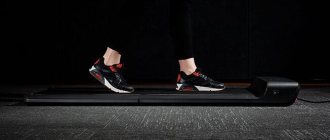September 10, 2016 Admin Home page » Tips and recommendations
Find out whether you need to take a break from training or whether you should train endlessly. Important tips and recommendations about physical activity to create a beautiful figure and good health.
Many have wondered whether it is necessary to take a break from training and how often? After all, there are days when you don’t feel like training, but you go to the gym, the body gets a load, but you don’t get much pleasure, everything is based on moral and volitional qualities, even if it doesn’t happen often, but everyone has had such a condition, you will agree.
Let's look at the main questions below and give answers to the thoughts that torment the mind about what and how to do correctly:
Do you need to take a break sometimes?
Don’t even think about this question – it’s necessary. Any activity after prolonged work requires rest. Over time, desire decreases, motivation drops, training is not carried out at full strength, exercise technique is lost, and in the end the famous state of “being unable to do something” sets in.
Also, do not forget that training puts stress not only on muscles, but on ligaments, tendons, joints, cartilage; fatigue of the musculoskeletal system increases from month to month, so it requires recovery.
Even fitness and bodybuilding stars take a break from training, which means that ordinary amateurs definitely need this. Imagine that the car will constantly drive under load without rest, the engine will fail faster, this is the same with our body, overtraining will eventually finish it off and the results will begin to fall.
What happens to strength and cardio after 2-4 weeks without training?
Two weeks
Strength indicators:
with a sedentary lifestyle (a trip to the nearest store does not count), the muscles will begin to lose their appearance within two weeks. “During this time, the muscles decrease in volume - this is due to the loss of water in the muscles. Without training, glycogen production decreases, so the muscles “deflate.” But this is reversible - two to three weeks after the start of training, they return to their previous shape,” says the fitness trainer.
Endurance:
For cardio enthusiasts, the situation is different. Compared to muscle strength, which is more tolerant of absenteeism, endurance indicators fall faster. “Without training, the heart muscle functions poorly, because it needs to be trained constantly. In the first time after stopping training, the VO2 max drops sharply - the maximum amount of oxygen that the body consumes during training. After 10 days, these indicators decrease by 7%, and even later – by 15%,” explains the fitness trainer.
Photo: unsplash.com/@lyfefuel
Four weeks
Strength indicators:
with light loads (climbing stairs, walking to the subway), muscle strength decreases after about four weeks. This is the conclusion reached by scientists from the American College of Sports Medicine. They studied the effect of a break in training on the strength performance of track and field athletes and weightlifters. And here's what it turned out: the athletes began to lose shape only after four weeks without training. In track and field athletes, the first to be hit were the slow muscle fibers - the same ones that can withstand a large number of repetitions and are used mainly in cardio training. In weightlifters, fast muscle fibers - large muscles that are not designed for high-repetition work - have suffered.
Get in shape: when to start exercising after contracting COVID-19
“A month after rest, glycogen stores in the muscles decrease. The fact is that muscles have certain nuclei that become larger during training. But as soon as you stop exercising, they decrease in volume,” says the fitness trainer.
Endurance:
after four weeks without training, endurance deteriorates by 20%. In 2018, scientists found that VO2 max (maximum oxygen consumption) levels decreased in runners four weeks after stopping training. A year earlier, scientists analyzed the sports performance of football players after the end of the competitive season and came to a disappointing conclusion. Running speed and cardiovascular condition worsened.
Olga Andrianova
fitness trainer
Endurance is lost much faster than muscle strength, especially if there has been no physical activity for a month. This is due to the fact that the volume of blood plasma decreases. The blood becomes more viscous, which “inhibits” the flow of H2O into the tissues.
Photo: unsplash.com/@mrleecanburn
How often to take a break and when?
Here you should focus on personal feelings and body conditions. If you have a series of injuries - sprains, joint pain, general fatigue of the body that lasts for quite a long time, or the working weights drop and the results do not want to improve. At the same time, the whole body hurts from aching pain and this is not always muscle pain.
Even if you are full of strength and energy is in full swing, give your body a holiday 2 times a year, and instead of working in the gym, actively include swimming, cycling or stretching on your rest days, don’t worry, you won’t weaken, but your body will get rest and when you return to training, it will reward you with new sports results.
How important is sleep for recovery after exercise?
To stay fit and rested, it is important to maintain a healthy sleep schedule of seven to nine hours. If you can't get enough sleep, the doctor recommends taking a nap during the day. “Sleep is essential for both physical and mental performance. After all, sports are not just about building muscles, but also about cognitive skills, such as learning new movement processes. And we can do this better if we’ve had a good night’s sleep.”
Instagram content
This content can also be viewed on the site it originates from.
How long should the break last?
This depends on the general exhaustion of the body, each body has a unique system, some recover faster, some slower, but in any case, the break in training should be at least 7 days and no more than 30.
If there are no injuries, then the break should not be long; with injuries, the duration increases, since if you start training without recovering from an injury, you can fly out of sports life for a longer period.
In any case, you must understand that the longer the break lasts, the harder it will be to get into a sports rhythm; the muscles will need more time to regain their former strength and endurance.
How to start training after a long break?
- After a long rest (three months or more), you will have to start everything from scratch - this is long and painstaking work. You need to increase the load slowly and gradually – both in cardio and strength training, says the fitness trainer.
- A break of six months will cost you 1.5-3 months of recovery. Returning muscles to their previous shape in a month is unrealistic.
- The first two weeks of training after rest, the body will resist. But after three or four workouts it will be easier to practice.
- If the absences were no more than 10 days, you can start with light walks. Then move on to more active sports, where the pulse zone reaches 125-150 beats per minute. In this case, the heart muscle works more actively, aerobic abilities increase, the fitness trainer concludes.
Is it necessary to stop training completely?
This is everyone’s choice, some are more, some are less obsessed with sports, some experience withdrawal from lack of physical activity, while others simply enjoy idleness and relaxation.
However, you should know one thing, those who during rest prefer light training with their own body weight - squats, pull-ups, parallel bars, abdominal exercises and aerobics, after rest will get in shape almost immediately, while those who are completely rested will have to spend a little time to regain your previous physical state.
The choice is yours, do what is convenient for you and focus on how your body feels.
How to Know When You Need a Time Out
Neglecting rest not only affects your level of performance: “You feel tired and exhausted, you become more susceptible to infections and more often experience pain in your muscles and joints. In addition, lack of rest has a detrimental effect on hormonal balance: the level of growth hormones decreases, and stress hormones increase. Another consequence may be problems with weight: despite playing sports, the kilograms will not go away.” Normal muscle pain, on the other hand, is not a typical sign of overtraining, as the expert explains, but simply a reaction to an unusual load.
Instagram content
This content can also be viewed on the site it originates from.
Study of intervals for muscle volume and strength growth
A group of 21 young men were randomly divided into 2 subgroups: one rested 1 minute between sets, and the other 3 minutes.
All other components of the training program remained unchanged. The subjects trained in a standard bodybuilding-oriented style, performing 7 exercises and working all the major muscle groups of the upper and lower body.
For each exercise, 3 sets of 8-12 repetitions were performed, while the training itself took place 3 times a week for 8 weeks.
We tested participants before the study and immediately after its completion. The bench press and squats were used as test exercises to determine the growth of strength indicators (indicators were determined based on the growth of 1RM). Specific hypertrophy parameters of the elbow flexors, triceps brachii, and quadriceps femoris were assessed using two-dimensional ultrasound (US).
The main thing is to move!
To summarize, people who are consistently engaged in aerobic training should not worry about short-term cessation of physical activity: one to two weeks is not enough to cause noticeable muscle loss. But a long pause in aerobic training can cause a deterioration in such indicators as the maximum amount of inhaled oxygen. To stay in shape, it's worth remembering this.
With a short pause in anaerobic training, fast muscle fibers are lost, but they can be restored by returning to hard training after a break: this is facilitated by hormonal changes that occur in the body during the rest period and muscle memory.
Moreover, even light physical activity will help not to lose the accumulated muscle base. The main thing is not to lie down permanently. And if you had to lie down, do so without giving in to stress and, if possible, doing simple exercises.
This is supported by the results of a large meta-analysis involving 44,370 people in four countries who tracked their physical activity using a fitness tracker. The recommendations that can be made in accordance with this study are very easy to implement: take the stairs instead of the elevator, play with children and pets, do yoga or dance, ride a bike, do household chores or just walk for 30-40 minutes. activities will help compensate for a day of hard work at a desk and prevent muscle atrophy.
Breaks between exercises
Before you develop a training plan, you need to have an idea of what you want to achieve through training and in what period of time. The more precisely you define your goals, the better you can understand what interval of breaks is suitable . To achieve maximum effort of the nervous and muscular systems, you need a load with which you can perform short, maximally intense muscle contractions . Increased strength can only be achieved through enormous free effort, which must be performed with a short intense onset and which will ensure the activation of high-threshold muscle nodes. A motor unit is a basic functional and biomechanical unit consisting of a group of muscle fibers innervated by a single motor neuron.
Miroslav Petr and Petr Šiastny argue that “full concentration and maximum free effort can only be achieved if each subsequent series is carried out under conditions of complete restoration of the energy sources of the ATP-CP system” [1] That is, maximum effort is desirable for full or almost complete recovery , which is associated with maintaining periods of rest.
However, for each type of training we can think of maximal effort as something different.
• Maximum Strength – Reps range from 1-5, with sets ranging from 0 to 20 seconds, the body requires maximum recovery, which can be achieved with a rest period of 180-300 seconds.
• Maximum strength and hypertrophy – 6-8 reps, 20 to 40 seconds, rest interval 120-180 seconds.
• Hypertrophy – 9-12 reps, 40-70 seconds, rest period 120-75 seconds.
• Endurance Training – Endurance Strength – should use higher reps (13-25) for 50-120 seconds and partial recovery for 75-10 seconds.
Thus, everything can be explained in one sentence: the greater the resistance used during the approach, the longer the body requires a rest period. This information can be used to achieve maximum performance in each training approach. [3]
However, if your goal is to increase muscle mass (hypertrophy), a combination of moderate intensity (9-12 repetitions) associated with shorter intervals of 30-60 seconds causes a faster increase in growth hormone . This only works for muscle hypertrophy. “In low-repetition workouts that require increased rest time between sets, post-workout growth hormone production is minimal” [2]
In addition, shortening the rest time between repetitions to 30 seconds allows you to increase your heart rate, which increases the benefits of aerobic exercise during your workout. Such short breaks are considered most effective in the period before a competition (drying) or for burning excess calories more quickly. supersets or trisets are used a few weeks before the competition . A superset is two exercises alternating with a 30-second break, and three sets rotate the three exercises the same way. For example: Exercise 1 – Bench press with a barbell followed by a pause – max. 30 seconds and exercise 2 – pull the block to the chest and again pause for 30 seconds. This counts as one set of a superset . [4]
What happens to muscles when they are not used - for example, in the case of bed rest?
The answer to this question was found by doctors at the University of Texas Medical Branch research center.
In order to evaluate muscle protein synthesis, muscle mass and strength characteristics, they conducted an experiment. A group of healthy men were given 28 days of bed rest to simulate the stress experienced during illness (the subjects received special drugs to reproduce plasma concentrations of the hormone cortisol corresponding to injury or disease). The control group of volunteers was in a hospital without simulating stressful conditions.
Bottom Line: Physical inactivity coupled with the hormonal stress response to injury or illness led to loss of muscle mass, leg extension strength, and muscle protein synthesis in otherwise healthy men. Compared to the group who were in a hospital bed just for the sake of rest, their loss in leg extension strength was 28.4% greater, and their leg muscle mass decreased by 3 times.
The conclusion that is obvious from this experiment is that 4 weeks of inactivity alone is not as dangerous as the combination of complete inactivity and the stress caused by the disease.










